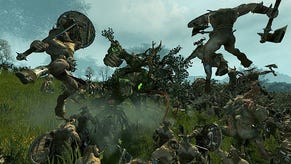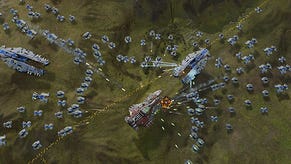Wot I Think: Ashes of the Singularity Singleplayer
Partial annihilation
Ashes of the Singularity [official site] was released last week after months in early access, promising huge Supreme Commander-style battles and furious tactical decision-making. But is it simply walking in the giant robot footsteps of its predecessors? Brendan tells us wot he thinks.
One of the lines of Ashes' marketing goes: "win the battle with strategy, not speed". I am here to tell you: that is nonsense. This is about as speed-clicky an RTS as you can get. There are parts of its design that will (theoretically) make you consider your approach more thoughtfully. But make no mistake, this is as traditional as shepherd's pie. Even an AI opponent on the Normal setting will be pumping out tens of actions every second, so have your murder tendons ready. You will need to be fast.
Ashes has been pitching itself for the past year as a spiritual successor to Total Annihilation. In many ways, it fits this description, and maybe too well. As an artificial intelligence you are part of the Post-Human Coalition, fighting an enemy known as "splinters" - supposedly drones without autonomous thought. It's a silly setup but it's all that is really required. The game has a story mode called 'Ascendancy Wars' (more on this later), a skirmish mode against (other) AIs and the usual multiplayer options.
There are also a few extra 'scenarios'. King of the Hill is a defensive scrap for survival against waves and waves of increasingly difficult armies. Overlord is a 3 v 1 match up, pitting you and two lesser-brained robofriends against a nasty AI enemy with some of your unit options made unavailable.
As far as the minute-to-minute war machine goes, all is present. You capture waypoints blessed with metal or radioactive deposits, then plop down metal extractors or radioactive sucker-uppers to eat the material and add it to your income (later you can build an energy-enhancing construct on these waypoints to increase your uptake). Factories pump out small units - speedy scouts, rocket-launching "archers", cheap "brutes", medical repair bots and so on.
Meanwhile, armories and sky factories add bombers, fighters, anti-aircraft tanks, powerful "sniper" units and wonderful, wonderful artillery. These latter tanks launch a gorgeous volley of rockets at enemies, even if they are out of sight. They can do this because the edge of the game's "shroud" will glimmer with red if any enemy units are close to your own. Eventually you'll be able to make tier 3 vehicles and "dreadnoughts" - huge capital floaters that can be upgraded the more they fight.
This "upgrading" feature isn't limited to the big guns, however. A third resource, called Quantum, can be supped from the earth with another building. This allows you to upgrade the health, firepower and radar range of your entire force, as well as increase the storage capacity for the other resources. It's also a kind of battle cash you can use to summon orbital abilities - things like revealing terrain, unleashing a plasma storm, dropping an engineer or a squad of bots far from HQ.
I was pleasantly surprised (miffed) when an enemy AI smashed my swarm of 25 bombers with a single blast of the destructive orbital strike, just as they were about to raid a little metal farm it had built. This AI went on to win the game by collecting enough Turinium - something gathered by holding power stations. The other way it could have won is by flattening my central "nexus" - my home base. I got off easy.
This all looks wonderful and seeing artillery shells arc through the sky isn't the only time you'll smile at the scale and grandeur of your army's skirmishes. Queuing bots so that they march out of your factories to form unstoppable columns is just as interesting as it has always been. But this is the thing - it is just as interesting. Not more.
Ashes is deep in the shadow of its great loves and entrenched in a way that makes it, well, sort of tired. There is nothing very novel about huge numbers of troops - we have been able to command such forces for decades. And while units like the Artemis artillery and the more advanced Dreadnoughts are fun to steamroll around with, some of the units are so bland they don't even stand out against the snowy, cratered ground. And they all look more or less the same, there's very little distinct about the design or operation of each toy. Some vehicles of the Substrate (the second faction) are fun, like the dreadnought that looks like a giant brain in a pod. But most of them are identikit alien wobblecraft.
You can highlight a bunch of troops and click a command to form an "army". This is one of the things the game emphasises. The idea behind composing armies is that each swarm will be the sum of its innards. So an army with a lot of heavy, slow dreadnoughts will be slower but pack more punch. An army with a lot of scouts will see its overall speed increased, meaning it (theoretically) pays not to ignore the lightweight speedy guys, like you would in so many RTS games. But this "sum-of-its-parts" mechanic (the devs call them 'meta-units') is never really all that obvious. You can stack a battalion with medics and notice some survivability but apart from that I never really became consciously aware of any increase in speed or range.
This might be because there was no viable way to measure any differences apart from making a purposefully distinct group. And in the heat of battle, you don't have time to or resources to experiment. A lot of armies end up being such a mish-mash that you stop caring about composition and simply go for pushing hard with big numbers. Getting the next batch of metal extractors is, as always, more important than tinkering with your troops.
The most I thought about the make up of my forces was how best to complement ground troops with bombers, and how many fighters should come along for the ride. But how is this any different from the way you simply group things in other strategy games? In the end, it feels no different at all.
I can forgive any RTS that holds tradition in high esteem but there are other things that irk me about Ashes. In the Ascendancy Wars - the story mode - there are 11 planets that make up the threads of a sci-fi tale. They swivel between being annoyingly hand-holdy and boot-to-the-balls debilitating. At first the desire seems to be to introduce the player to the different concepts one by one - ground units, resource capturing, the tech tree. For the first three missions everything seems fine. Then the fourth mission shows up and punches you in the kidney. "This isn't a tutorial," it seems to say, "this is your gruesome death."
This infuriating mission tasks you with holding out against waves of various enemy units with very little in the way of available resources. So far, so good. Then ten minutes into the mission, the tutor bot pops up and says: "oh yes, by the way, there are dozens of aircraft coming to blow you up. I guess you should have this." At which point he grants you - at the very last minute - the option to build AA-guns and AA vehicles, none of which you can build fast enough because the airplanes are basically already on top of you, bombing your engineers to death.
It is intensely frustrating to have to repeat what is essentially a tutorial mission half a dozen times. The result is a straitjacketing scene in which you have to wait for some videogame Clippy to pop up and bless you with an ability, one which you ALREADY KNOW, right from the start, is necessary to survive. I've seen a lot of players complain about the difficulty of this mission, so I know I'm not alone. It can be overcome, but it's such a spike it makes your teeth grind.
Compare this to Planetary Annihilation, which also sought to revive the grand scale, spirit and pace of Total Annihilation and SupCom. PA had its problems (it was a rushed and the devs sold a follow-up game by tweaking some things and then simply adding the sub-name "Titans"). But at least it approached the revival of its inspirations not only with a dash of originality, allowing you to invade and swarm over multiple, spherical planets, but also with a lot of its own visual character.
It was just as tough-as-nails as this outing can be, but it brought so much more to the table. I can't in good faith recommend Ashes when the true inheritor of Total Annihilation's twisted and burnt crown already exists in the form of Uber Entertainment's interplanetary wreck session.
I'm making this sound worse than it is. For anyone yearning to see tanks flooding in and out of canyons in a way that brings them right back to 1997, you may well have what you want. But if the veil of nostalgia doesn't tempt you, you're not going to be convinced.
Overall, Ashes isn't bad, it's just very plain. Gorgeous, but plain. There's nothing here that hasn't been done before and done better. And I certainly don't think it has the spark that made Company of Heroes so excellent, despite what the developer may suggest (even if you can make a "veteran" of your biggest tank). You can win the battle here with speed, and maybe a little strategy. But, being entirely honest, I wouldn't recommend battling at all, in singleplayer at least.
Ashes of the Singularity is available now. We'll have a close look at the multiplayer side of the game next week.













